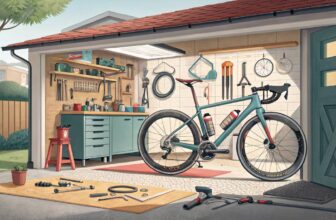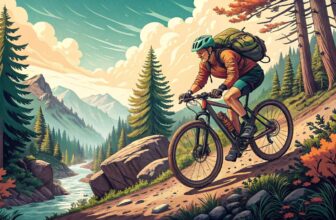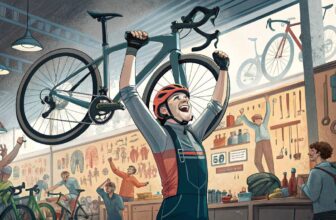Finding the Right Bike Size
Getting the right bike size is like finding that perfect pair of sneakers—it’s gotta feel just right. Let’s dive into the ins and outs of picking the best fit for kids and adults.
Children’s Bike Sizes
When it comes to kids’ bikes, you gotta balance their age with their height for the right wheel size. Here’s a quick cheat sheet:
| Age | Wheel Size |
|---|---|
| 4 | 16″ |
| 6 | 20″ |
| 9 | 24″ |
| 10+ | 26″ to 700C |
Parents, you might be scratching your heads about when your kiddo is ready for an adult-sized bike. Most kids hit that growth spurt by age 10, making them tall enough to handle bikes with wheels oscillating between 26″ and 700C.
Adult Bike Sizes
Adults, you gotta look at the frame size that’s right for your biking style, be it zipping down city streets or tackling mountain trails:
| Bike Type | Measurement | Common Sizes |
|---|---|---|
| Road Bikes | Centimeters | 51cm, 54cm, 56cm |
| Mountain Bikes | Inches | 15″, 17″, 19″, 21″ |
Each company seems to have its own lingo, throwing around terms like small, medium, and large. Because of this, it’s smart to peep at a geometry chart to nail down the best fit. Don’t skip checking the brand’s guidelines either—those folks know their stuff.
For more tips on finding that sweet fit, you can peek at our guide on bike frame sizing, and if you’re in the market for some buying tips, have a gander at our bike price guide.
Mountain Bike Sizing Guide
Finding the perfect mountain bike is a game-changer for comfort and performance on the trails. Getting your head around the basics of bike measurements, particularly reach and stack, is key to making a smart choice.
Mountain Bike Geometry
This fancy term basically means all the numbers that decide how your bike feels and handles. Unlike sleek road bikes, mountain bikes are all about mastering rough terrain. Here’s the lowdown:
- Head Tube Angle: Affects how sharp or relaxed your steering feels.
- Chainstay Length: Influences if you’re riding a wild bronco or a stable stallion.
- Bottom Bracket Height: Determines how balanced and steady you feel, keeping you from going head over heels.
For more juicy details on how these measurements play out, check out bike geometry explained.
Key Measurements: Reach and Stack
When it comes to selecting the sparkling new set of wheels, reach and stack steal the show.
Reach:
- This is the horizontal path from the middle of where the pedals are to the top of the front tube.
- It shifts big time across bike sizes and is a major player in setting your style and grip.
- Those experts over at Evo say that as the frame size goes up, so does the reach, opening up more space up front.
Stack:
- Stack measures how tall the bike is from where the pedals sit to the top of the front tube.
- It’s usually pretty steady but can still totally change how cozy you feel.
Here, have a look at the basic numbers for different bike sizes:
| Frame Size | Reach (mm) | Stack (mm) |
|---|---|---|
| Small | 405 | 600 |
| Medium | 430 | 610 |
| Large | 455 | 620 |
| Extra Large | 480 | 630 |
If you’re curious about turning those numbers into a frame size, hop over to bike frame sizing.
Finding Your Sweet Spot:
- The trick is balancing reach and stack to match your body and style.
- A stretched reach can mean speed and stability, making you feel like a pro racer.
- A taller stack can help with comfort, especially when roughing it over rugged tracks.
For newbies or those who’ve turned in their old ride, this info’s your ticket to smart shopping. Dive into how to test ride bike for tips on ensuring a dreamy fit.
Grasping the ins and outs of mountain bike geometry and these crucial measurements means your bike will fit like a glove, boosting every ride. If you’re itching for more details, our bike size calculator is at your service.
Understanding Bike Frame Sizing
Getting your hands on the right bike can be a bit like dating: it requires a blend of chemistry, compatibility, and let’s face it, a dash of luck. Central to your cycling bliss is knowing what size frame fits you best. Let’s simplify this ride, skipping the awkward bits like frame sizing jargon that’ll only leave you more puzzled than finding a rubber on the road.
Seat Tube Length
Kick it off with the seat tube length—basically, this old-school measure tells you the bike’s size without so many guessing games. It’s a straight line from the bike’s bottom bracket (where those crank arms twirl) to the top of the seat tube or where it meets the top tube.
Frames flaunt sizes in centimeters or inches, but here’s the kicker—not every manufacturer sings the same tune. Sometimes you’ll just see “small,” “medium,” or “large,” and it’s anyone’s guess what that translates to numerically. Here’s a handy table to keep you on track without a derailleur mishap:
| Frame Size Label | Seat Tube Length (cm) | Seat Tube Length (in) |
|---|---|---|
| X-Small | 48 – 50 | 18.9 – 19.7 |
| Small | 51 – 53 | 20.1 – 20.9 |
| Medium | 54 – 56 | 21.3 – 22.0 |
| Large | 57 – 59 | 22.4 – 23.2 |
| X-Large | 60+ | 23.6+ |
Don’t forget, biking bliss isn’t all about seat tube length. Things like standover height matter too, especially when you’re picking out a set of wheels for your kid. A good rule? Aim for a 2-inch clearance above the top tube for safe rides.
Frame Size Conversion
Gone are the days when seat tube length ruled the roost—nowadays, bike makers are going all-in on fancy terms like reach and stack. This newer, cooler system lets you play around with bike fitting until you’re grinning from ear to ear.
Reach and Stack
Here’s the lowdown: Reach measures how far you’ve got to lean over from the bottom bracket to the head tube’s top-center. Stack? It’s all about height, from the bottom bracket to the top-center of the head tube.
This approach is way more current ’cause it adapts to different body shapes and riding vibes. Long reach equals mega stability at top speeds, while a higher stack means a comfier, relaxed posture. Geometry? It’s aced!
Conversion Chart
Alright, let’s translate those traditional sizes into reach-stack lingo so you don’t overthink it:
| Frame Size Label | Reach (cm) | Stack (cm) |
|---|---|---|
| X-Small | 38 – 40 | 54 – 56 |
| Small | 40 – 42 | 56 – 58 |
| Medium | 42 – 44 | 58 – 60 |
| Large | 44 – 46 | 60 – 62 |
| X-Large | 46+ | 62+ |
When you’re contemplating which bike brand or model to go for, knowing this stuff is a lifesaver, especially if you’re just jumping into the cycling world or deciding it’s time for an upgrade. It gives you that perfect feel, like finding just the right fries to ketchup ratio (useful stuff).
And hey, if you wanna dig deeper into the spice of bike sizing and geometry, check our guide on bike frame sizing and bike geometry explained before you make that call on your next two-wheeled adventure!
Factors Affecting Bike Fit
When it comes to bikes, the devil is in the details. A bike’s fit and feel rely heavily on certain key factors, each with its quirks that affect how the bike handles and rides. These measurements are your road map to choosing the right size and achieving the ride of your dreams.
Head Angle and Handling
Think of the head angle as the steering wheel of your bike. This mighty angle on the front end impacts how your bike maneuvers and stays upright. A more laid-back (or slack) angle is like a lazy Sunday drive—stable and smooth, especially when you’re zooming downhill or speeding along flat trails. Meanwhile, a more upright (steep) angle equals quick, dance-like moves, perfect for climbing hills and twisting through tight turns.
| Head Angle | Performance |
|---|---|
| Slack (e.g., 66°) | Smooth and stable at breakneck speeds, great for downhill |
| Steep (e.g., 72°) | Quick turns and nimble handling, ideal for uphill |
This angle teams up with other specs like the fork rake (offset) to determine your bike’s vibe. A steep angle paired with short offset forks makes a bike quick on its feet, catering to cross-country crusaders. Swap that for a slack angle and longer offset, and you’re looking at a bike built for the big, wild world of downhill racing.
Chainstay Length Preference
Let’s talk about the bike’s back end—chainstay length. This tells you whether your bike’s gonna be a sleek, trick-doing machine or a stable beast ready to handle any gnarly terrain. Short chainstays mean the bike can turn on a dime, making it perfect if you fancy carrying out wheelies like a pro.
If you’re more about smooth cruisin’, longer chainstays are your buddies. They ensure a stable ride, especially when barreling down those high-speed hills or diving into rocky escapades.
| Chainstay Length | Performance |
|---|---|
| Short (e.g., 420mm) | Agile and ready for stunts |
| Long (e.g., 440mm) | Steady ride at high speeds, ideal for rugged paths |
Your choice here really depends on where your heart leaves skid marks: an agile bike for nailing tricks or a stable one for owning the trail. Preferences are personal—no right or wrong. It’s all about how and where you like to ride.
For more geeky bike geometry chat, check out our lowdown on bike frame sizing, and see how stem length and handlebar position tweak the entire experience. Avoid those rookie bike buying mistakes—knowledge is power for a smart buy.
Matching head angle with chainstay length is like putting peanut butter and jelly together. When done right, it makes your biking experience just as sweet and savory as you like it. Ride on!
Stem Length and Handlebar Position
Impact on Bike Handling
The magic stick, aka stem, is your bike’s bridge between the handlebars and the fork. It’s a small piece, but oh boy, does it pack a punch in shaping your ride’s feel. Get it right, and you’re zooming past the rest with precision, comfort, and less wear on your bones.
How does it affect your ride? Let’s break it down simply:
- Stability and Control: Longer stems act like a steady rudder, perfect when you’re flying downhill or touring for miles. Short stems? They’re the ninjas—swift with sharp turns—not bad when dodging through city streets or handling twisty trails.
- Comfort and Ergonomics: Pick a stem too long, and you might feel like you’re reaching for the stars, not great for the back. Too short? You’re scrunched up like an accordion. Finding that sweet spot keeps you comfy and in control.
| Stem Length | Handling Style | Best For |
|---|---|---|
| Short ( < 90mm ) | Quick turns | City rides, tech trails |
| Medium ( 90mm – 110mm ) | Balanced feel | General road biking, leisurely rides |
| Long ( > 110mm ) | Steady as she goes | Downhill adventures, cruising long distances |
Finding the Right Stem Size
Now, getting the right stem isn’t a roll of the dice. You gotta consider your build, where you like to ride, and whether you’re as limber as a yoga instructor or stiff as a board. Carbon Speed Cycle can hold your hand through the details if needed.
What to Think About:
- Your Height and Arm Span: Tall or with the arm’s reach of an orangutan? Longer stems might suit you better. Short with T-rex arms? Shorter stems for more comfort.
- Your Riding Vibe: Long stems suit those who love speed trials or descending steep hills. If you prefer weaving through city traffic or tricky trails, a shorter stem will have your back.
- Yogi or Not: Flexible folks might swing to longer stems without a hitch. If touching your toes is more myth than reality, stick to shorter stems to keep the aches at bay.
Want to nail that perfect fit? Try a few stems on for size, or experiment with adjustable ones if you can. Our advice? Swing by our how to test ride bike tips for a trial run.
A few tweaks here and there—and bingo, your bike fit can feel like a custom-made suit. Need more on bike frames and what they mean? Peek into our bike frame sizing guide. Combine that with a spot-on stem length, and you’ll be on the road to riding happiness!
Adjusting Saddle and Handlebar
Saddle Height Adjustment
Getting your bike’s saddle height just right can be the difference between a smooth ride and an achy one. To ballpark it, add about 13 cm (or 5 inches, for you folks in the US) to the length of your trouser leg. From the top middle of your saddle to the top middle of the pedal, this sort of accurate measure serves as a first pass.
For nailing it down:
- Sit firmly on your saddle.
- Set the cranks so one’s pointing straight up and the other’s down.
- Adjust the saddle until, with your heel on the lower pedal, your leg stretches nicely straight when at the pedal’s lowest point.
Proper saddle height stops your hips from swaying like a mischievous kid, keeps your knee slightly bent when the pedal’s at rock bottom, and ups your pedaling game while saving your knees a world of hurt.
| How to Measure | What’s Involved |
|---|---|
| Trouser Leg + 13cm | Basic guesswork |
| Heel Method | Ensures leg stretch |
Handlebar Positioning
Nailing your bike’s handlebar setup is like finding the sweet spot between lazy Sunday rides and zooming like you’re late for a date. How you like things depends on stack height, the steerer tube length, how high up or down that stem sits, and any rise in the bars themselves.
Some folks want their handlebars as high as the saddle for a chill cruise, while hardcore racers drop them down low, adding aerodynamics to their adrenaline. Try different stem lengths and bar shapes ’til it feels just right. Here’s a handy trick:
- Rest your elbow on the saddle tip.
- Point that index finger out towards the stem and gauge the fit.
This gets ya started on sussing out the right handlebar reach.
| Adjustment Thingamajig | What’s It Do? |
|---|---|
| Stack Height | Adjusts how high up you get the bars |
| Steerer Tube Length | From center clamp to the bar ends goes vertical |
| Stem Height and Rise | Impacts reach and stance |
| Handlebar Rise | From the center clamp to the bar ends goes vertical |
Fiddling with these bits lets you tweak your ride for primo comfort and pedaling prowess. Remember, your body’s quirks and how you plan to put the pedal to the metal are your guides. For more deep dives, see our bike frame sizing or bike geometry explained pages.
Saddle Position on Mountain Bikes
Gettin’ that saddle just right is key to staying comfy and kickin’ some dirt out there on the trails. Two biggies to nail down are your saddle height and how that seat’s sitting overall.
Setting the Saddle Height
Dialin’ in your saddle height needs a few easy peasy steps. Start by measuring your pants leg and add about 13cm (or 5 inches). That’s from the center top of the saddle to the top of the pedal. To keep your pedal game strong and smooth, try this:
- Sit nice and even on the saddle with the cranks lined up—one up, one down.
- Tweak the seat so when your heel’s on the lower pedal and your leg’s straight, the crank reaches low.
- Double-check that your knee’s got a slight bend while pedalin’—it keeps those hips from wiggling too much.
Havin’ your saddle height just right keeps things chill and makes sure you’re not wearin’ yourself out too quick.
| Measurement | Ballpark It |
|---|---|
| Saddle Height | Pants leg measurement + 13cm (5in) |
| Knee Angle while Pedalin’ | Just a Slight Bend |
Correct Saddle Position
Gettin’ your saddle in the right spot matters for both cozy rides and how well you handle the bike. Keep the top of your saddle mostly flat; it’s solid for those cross-country treks. If you’re trickin’ it or zoomin’ down steep paths, you might lean it back a smidge for better control.
- Forward/Backward Tweakin’:
- A saddle too far back? Your ride might feel like it’s always tilting.
- Too much forward? You could feel all squeezed up when biking.
- Reach and Arm Factor:
- Folks with long arms tend to push the saddle back.
- Shorter arms? Some might go for seatposts that let the saddle sit up front.
Mix these bits to make that mountain bike feel just right for you. For more tips and tricks, peek at our articles on bike frame sizing, compare bike specs, and bike geometry explained.
Personalizing Your Mountain Bike
Snagging your dream mountain bike isn’t just about looking cool on the trails—it’s about making it truly yours so it feels like an extension of yourself. Whether you’re cruising or tackling tough terrain, customizing your ride can take your biking adventures to another level. Tweak a few bits and pieces, and you’ll be set for comfort and smooth sailing (or riding).
Component Adjustments
Let’s dial into those bike bits. They might seem like tiny tweaks, but getting them right can make all the difference. Here’s the lowdown:
- Stem Length: This is the part that links your handlebars to your bike’s steering. The right length has everything to do with how comfy you feel and how precise you steer. It’s like the magic link between you and your bike’s soul, helping you strike that sweet spot between agility and ease.
- Handlebar Height and Position: Fiddle with this one, and you can switch up your biking stance big time. You might want your bars even with your seat for a laid-back vibe or lower them for a more aggressive takeover of the trails. Find that happy balance, and you’ll feel like a rockstar.
- Fork Rake/Offset: Ever wonder how some folks zip around corners like they’re on rails? Thank Fork Rake, the often-unsung hero of mountain biking. More rake equals quick turns, less rake means steady as she goes.
Making the Ride Comfy
Comfort is not just a perk – it’s what makes your rides a joy. Adjust these details to skip the aches and focus on the thrill:
- Saddle Height: Set this wrong, and your knees might start singing the blues. Nail it, and every pedal stroke will feel like a symphony (Read more).
- Handlebar Reach and Positioning: Feel cramped up or like you’re reaching for the stars? Adjust that stack height or try some funky handlebar shapes until everything feels just right. A fun trick? Rest your elbow on the saddle, stretch out your longest finger towards the stem, and see where you land.
| Component | Effect on Comfort | Adjustment Tips |
|---|---|---|
| Stem Length | Posture, steering | Adjust for your torso and arm length |
| Handlebar Height | Riding stance | Start with bars even with the saddle, tweak from there |
| Fork Rake | Stability and turning | Add rake for quick turns, reduce for more control |
Got the itch for more bike nerd knowledge? Check out our bike geometry explained guide and soak it all in.
Dialing in these tweaks not only helps you feel right at home on your bike but also boosts your ride’s performance big time. Still unsure? Dive into our bike frame sizing and bike size calculator to keep exploring what fits best. A few simple adjustments and you’ll be zooming down trails with a grin that just won’t quit.




